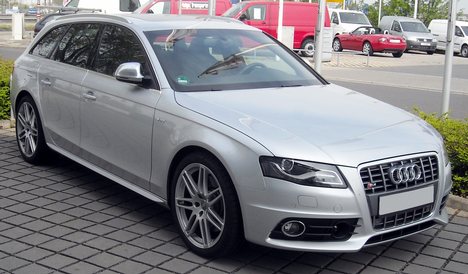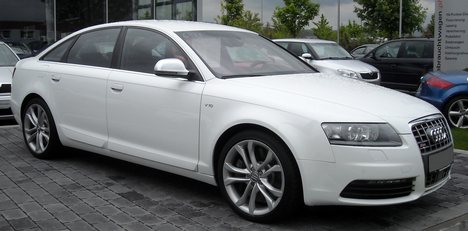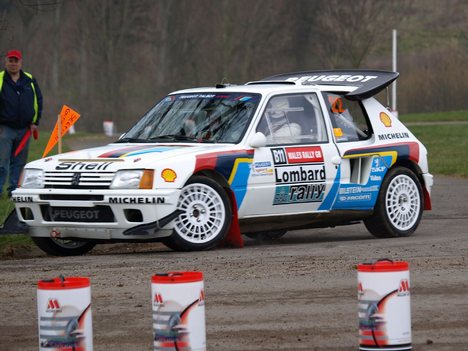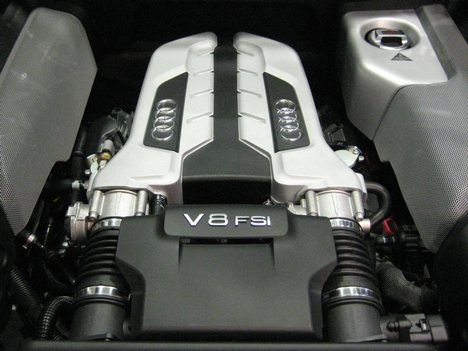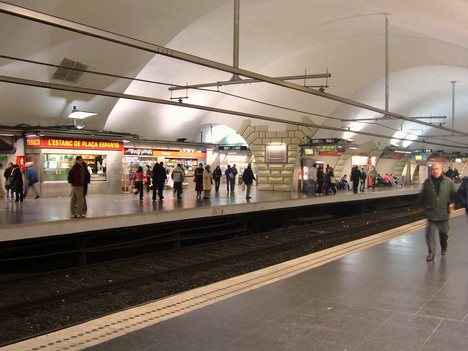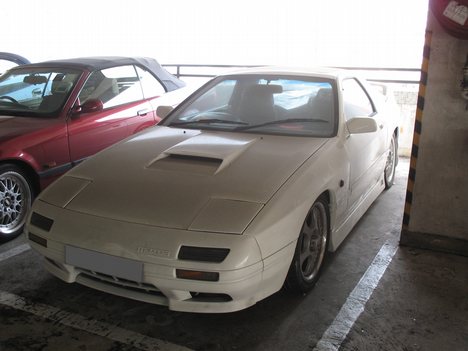
- Order:
- Duration: 3:35
- Published: 13 Oct 2009
- Uploaded: 24 Feb 2011
- Author: InsideLineVideo
| Name | S4C |
|---|---|
| Logosize | 200px |
| Logofile | S4C logo.svg |
| Logoalt | S4C logo |
| Launch | 1 November 1982 |
| Picture format | 576i (SDTV ) 1080i (HDTV) |
| Share as of | February 2008 |
| Share source | |
| Owner | Welsh Fourth Channel Authority |
| Country | Wales, United Kingdom |
| Headquarters | Llanishen, Cardiff |
| Web | |
| Terr serv 1 | Freeview |
| Terr chan 1 | Channel 4 (Wales only) |
| Terr chan 2 | Channel 53 (HD) (Wales only) |
| Sat serv 1 | Freesat |
| Sat chan 1 | Channel 104 (in Wales) Channel 120 (rest of UK) |
| Sat serv 2 | Sky |
| Sat chan 2 | Channel 104 (in Wales) Channel 134 (rest of UK) |
| Sat serv 3 | Astra 2A |
| Sat chan 3 | 12129V 27500 2/3 |
| Cable serv 1 | Virgin Media |
| Cable chan 1 | Channel 167 (only in Wales) |
There were initially two versions of the channel: the first, broadcast on analogue television, was bilingual (Welsh and English) with most of its English-language programming being either simultaneous or deferred broadcasts of Channel 4 programmes (analogue reception of which was unavailable in most of Wales); the second, on digital television a 100% Welsh-language service, branded (S4C Digital).
The analogue version of S4C closed on 31 March 2010, when the Wenvoe transmitter completed the digital switchover. After this S4C Digidol became the default S4C channel available across Wales available to Welsh viewers on cable, satellite and Freeview.
A high definition service called S4C Clirlun (clear picture), simulcasting S4C Digidol, began broadcasting on 30 April 2010 on Freeview channel 53 in Wales. By the end of 2012, S4C plans to be producing all of its programmes in high definition.
In 1962 the ITV network had created a licence area for North and West Wales, which was awarded to Wales (West and North) Limited. This traded as Teledu Cymru and provided significant levels of Welsh-language programming. However, problems with transmission infrastructure and poor market research led to financial difficulties within two years and the station was taken over by its neighbour Television Wales and West.
During the 1970s, Welsh language activists had campaigned for a TV service in the language, which already had its own radio station, BBC Radio Cymru. Both the Conservative and Labour parties promised a Welsh-language fourth channel, if elected to government in the 1979 General Election. Shortly after the Conservatives won a majority in the election, the new home secretary Willie Whitelaw decided against a Welsh fourth channel, and suggested that, except for an occasional opt-out, the service should be the same as that offered in the rest of the UK. This led to acts of civil disobedience, including refusals to pay the television licence fee, thereby running the risk of prosecution or even a prison sentence, and sit-ins in BBC and HTV studios. Some took more extreme measures, including attacking television transmitters in Welsh-speaking areas. In 1980, the former president of Plaid Cymru, Gwynfor Evans, threatened to go on hunger strike if the Conservative government of Margaret Thatcher didn't honour its commitment to provide a Welsh language TV service. The channel started broadcasting on 1 November 1982, the night before Channel 4's opening. S4C appointed its first female CEO, Iona Jones in 2005.
To make them more accessible to English speakers, all Welsh language programming carries English subtitles on Teletext page 888, with Welsh subtitles on page 889. Both subtitle languages are also available on digital television platforms.
For speakers of English who are learning Welsh, certain programmes, particularly children's programmes and , carry subtitles on page 889 of Teletext, featuring Welsh subtitles with additional English translations in brackets next to more difficult Welsh language words.
TV movies produced for S4C have received some good foreign reviews; Hedd Wyn was nominated for the Best Foreign Language Oscar in 1993 and Solomon & Gaenor was nominated in 1999.
Those who have no interest in Welsh-language television have been known to point their aerials at the nearest English transmitters to avoid S4C, as well as BBC Wales and ITV Wales. However, this practice dates back before the start of S4C in 1982, when Welsh-language programming was included on BBC1 Wales and HTV Wales. S4C sports programme Sgorio has been known to reverse this practice, with English football fans watching S4C as the only British terrestrial broadcaster of Spanish and German league football.
The S4C analogue signal also spilled over into southeast Ireland. In the past it was rebroadcast in a number of areas there on UHF terrestrial signals by so-called 'deflectors', however Channel 4 is now re-transmitted from satellite by the few remaining deflectors. Up until the 1990s, S4C was also carried by some Irish cable and MMDS providers before being replaced by Channel 4.
Up until 2009, S4C ran its own teletext service, Sbectel (, Welsh for "a peek" or "a glimpse", and a reference to an S4C schedule insert formerly included in the TV Times issues for the HTV Wales region. is also Welsh for "spectacles").
In addition, S4C also operates a sister channel, S4C2. It formerly broadcast coverage of the National Assembly for Wales when in session. The programme content was provided by the BBC who, from January 2010, now make it available online and via BBC Parliament. Like the main channel, S4C2 is available within Wales on Freeview and throughout the UK and Ireland on Freesat and Sky, although it currently only broadcasts a holding caption. S4C2 had two audio feeds, allowing viewers to select between an untranslated version and an English-only version where all Welsh spoken is translated into English. Delayed coverage of Assembly proceedings is now broadcast overnight on S4C's main channel on Tuesdays, Wednesdays and Thursday.
In addition to the analogue TV signal transmitted throughout Wales, S4C, along with United News and Media, owned the company S4C Digital Networks (SDN). SDN was awarded the UK-wide contract to provide half a digital multiplex worth of programming. The other half continues to belong to the broadcaster Channel Five.
On 27 April 2005 S4C sold its share of SDN to ITV plc for approximately £34 million, though it still has the half-multiplex as of right in Wales. ITV already owned some of SDN due to the consolidation of the ITV industry: Granada bought UNM's stake in SDN, and this was then incorporated into the united ITV plc.
In January 2007, S4C announced plans to launch a Welsh-language children's service.
The new service launched on 23 June 2008. Under the name "Cyw" (), it brings together a wide range of programmes for nursery-age children, and S4C plans eventually to extend the service to include the "Stwnsh" strand for older children and a third service for teenagers and young people. The service currently airs on weekdays from 7am to 1.30pm on S4C.
The theme of the new idents was the magnetism of the Welsh society, represented by many objects gathering in one place, such as shopping carts at a grocery store, and golf carts at a golf course. These idents were produced by Proud Creative, a London based design firm. In 2007, another new set of live-action idents debuted, featuring live rendered dynamic elements which react to the voice of the continuity announcers, an effect similar to the initial idents of BBC Four - but utilizing live-action footage instead of 3D rendered footage.
On 28 July 2010, S4C's chief executive Iona Jones left her post without explanation. Assembly members and Members of Parliament have asked for an independent investigation into the circumstances leading up to her departure. The S4C Authority has refused to comment any further on the matter and commissioned a review into how the broadcaster is governed in August 2010.
From 2013, responsibility for funding S4C will begin to transfer to the BBC, with the DCMS reducing it's funding by 94% by 2015. The BBC will provide around £76m of funding to S4C by this date, resulting in a cut of around 25% to S4C's annual budget.
Category:Economy of Cardiff Category:Television channels in the United Kingdom Category:Welsh language Category:Television in Wales Category:Television channels and stations established in 1982 Category:S4C Category:Companies based in Cardiff
This text is licensed under the Creative Commons CC-BY-SA License. This text was originally published on Wikipedia and was developed by the Wikipedia community.
Henri Pauli Toivonen (25 August 1956 – 2 May 1986) was a Finnish rally driver born in Jyväskylä, the home of Rally Finland. His father, Pauli Toivonen, was the 1968 European Rally Champion for Porsche and his brother, Harri Toivonen, became a professional circuit racer.
Toivonen's first World Rally Championship victory came with a Talbot Sunbeam Lotus at the 1980 Lombard RAC Rally in Great Britain, just after his 24th birthday. He had the record of being the youngest driver ever to win a world rally until his countryman Jari-Matti Latvala won the 2008 Swedish Rally at the age of 22. After driving for Opel and Porsche, Toivonen was signed by Lancia. Despite nearly ending up paralysed at the Rally Costa Smeralda early in 1985, he returned to rallying later that year. He won the last event of the season, the RAC Rally, as well as the 1986 season opener, the Monte Carlo Rally, which his father had won exactly 20 years earlier.
Toivonen, driving a Lancia Delta S4, died in an accident on 2 May 1986 while leading the Tour de Corse rally in Corsica. His American co-driver, Sergio Cresto, also died when the Lancia plunged down a ravine and exploded. The fatal accident had no close witnesses and the only remains of the car were the merely blackened spaceframe, making it impossible to determine the cause of the accident. Within hours of the accident, Jean-Marie Balestre, then President of the FISA, had banned the powerful Group B rally cars from competing the following season, ending rallying's popular supercar era.
Toivonen started his career in circuit racing and was also very competitive on tarmac. He raced successfully in two World Sportscar Championship events and achieved praise from Eddie Jordan, in whose Formula Three team Toivonen made a few guest appearances. In his Formula One test for March Grand Prix, Toivonen managed to lap over a second quicker than the team's regular driver. It is often reported that during the 1986 Rally Portugal, he drove his Delta S4 at the Estoril track, and recorded a lap time which would have qualified him in sixth position at that year's Formula One Portuguese Grand Prix. The annual Race of Champions, originally organised in Toivonen's memory, awards the winning individual driver the Henri Toivonen Memorial Trophy.
Due to Finnish legislation, which at that time limited new drivers to a top speed of on open roads, Toivonen was unable to compete in rallying until he was 19 years old. While still focusing on his circuit racing career, he competed in his second world rally two years later and finished fifth in the 1977 1000 Lakes in a Chrysler Avenger.
Toivonen started his 1978 season at the Arctic Rally, the second round of both the European Rally Championship and World Rally Championship's "FIA Cup for Drivers", the predecessor to the official drivers' world championship which was established in 1979. He finished second, 3:41 minutes behind Ari Vatanen, and over seven minutes ahead of Markku Alén, who would go on to win the Cup. Toivonen went on to compete in two world championship rallies for Citroën. Although he did not finish either event, his driving attracted attention; a private Porsche team offered Toivonen a car for the 1000 Lakes Rally, as did Chrysler for the Lombard RAC Rally. At his home event, Toivonen had to retire due to an engine failure, but he finished ninth at the RAC Rally. These performances led to a contract with the factory Talbot Competition team for the 1980 season.
"I don’t think that I have done enough events to win the rally just by driving skill, for instance. If I win, it will be because I have a little bit of luck and some of the others have trouble. I mean, Hannu Mikkola knows the forests like the back of his hand so there is no use trying to drive to beat him. You have to wait for him to have trouble. Then you are in with a chance." Latvala stated that "It's a super feeling, it's almost unbelievable. Henri (Toivonen) was one of my idols and secretly I've always wanted to beat his record as the youngest winner." Over 20 years after the 1980 RAC, Paul White (nicknamed "Chalkie" by Toivonen) commented that he still receives questions about the rally and Henri Toivonen. He noted that the Talbot team, run by Des O'Dell and 15 full-time personnel, was much smaller than other works teams and "had to draft in 'mercenary' mechanics to help." Toivonen's results led to another year in the Talbot squad. In the 1981 season, he was signed up for a larger WRC programme and had a new co-driver, Fred Gallagher, who would later partner Juha Kankkunen and Björn Waldegård in a Toyota Celica Twincam Turbo. Toivonen's rear-wheel drive Group 2 Sunbeam Lotus was now less competitive against the Group 4 cars and the all-wheel-drive Audi Quattro, but despite four retirements, the second places at Rally Portugal and Sanremo, as well as a fifth place at the Monte Carlo Rally, resulted in a seventh place overall in the drivers' world championship. Together with more consistent team mate Guy Fréquelin, he brought Talbot a surprise manufacturers' title. He also competed in the last round of the British Open Rally Championship, the Audi Sport International Rally, and won the event. Toivonen's team mates were Ari Vatanen, who had won the previous year's championship (with Richards as his co-driver), the 1980 and 1982 world champion Walter Röhrl and Jimmy McRae, the previous year's British Rally Champion and father of future rally star Colin McRae. In his Ascona 400 debut in Portugal, Toivonen surprised the event favourites by leading the rally before retiring five stages from the finish. He competed in only four more WRC events, but finished on the podium twice, at the Acropolis Rally and at the RAC Rally.Toivonen continued with Opel into the 1983 season, now driving the Manta 400, which took advantage of the new Group B regulations. Although the Manta was a Group B car, it was underpowered against the likes of the Audi Quattro A2 and Lancia 037, which were controlling the world rally scene at the time. Toivonen achieved a win at the Manx International Rally, a round of the British Open Rally Championship and the European Rally Championship, in the Isle of Man, at his first attempt. He also finished first at the Mille Pistes rally in France, but the organisers decided to ban the Group B cars halfway through the event. Toivonen and his co-driver, Ian Grindrod, received only a consolation trophy. In late October, Toivonen again competed on the circuits. This time he entered two sportscar races, driving a Porsche 956 for Richard Lloyd Racing in the World Sportscar Championship. Partnered with Derek Bell and Jonathan Palmer, he finished fourth at Imola and third in the next race at Mugello.
Porsche (1984)
at the Goodwood Festival of Speed]] After a score of ten starts, two podiums, three other top six finishes and five retirements, Toivonen left Opel Team Europe for the 1984 season. He was linked to the lead drive at the Peugeot Talbot Sport, Peugeot's new factory World Rally Championship team, but eventually signed to drive a Porsche 911 SC RS for the Rothmans-sponsored Porsche factory team in the European Rally Championship. The team was run by Prodrive, a new motorsport group set up by David Richards, Toivonen's former boss at Opel. His European season with Porsche turned out to be a success. He started with two retirements, a third and a second place, but went on to win five rallies in a row and led the championship from Italian Lancia driver Carlo Capone. As Toivonen had a contract with Lancia for the World Rally Championship, and Lancia boss Cesare Fiorio wanted Capone to win the European title, it was suggested that Fiorio might enter Toivonen in WRC events to keep him away from important ERC rounds. However, Toivonen's title campaign ended in a back injury and a resulting enforced rest that was expected to take up to two months. He missed several events and finished second in the championship behind Capone.Toivonen's WRC contract with Lancia Martini consisted of five events. Fiorio stated that the team needed another top driver as "Audi will have four top drivers next year so it would be very difficult competing with only two." Toivonen had his Lancia 037 debut in Portugal with very limited testing experience: "It has been snowing in Italy every time I have been to try this car, so I don't know its limits." However, similarly to his Opel Ascona 400 debut at the same event two years ago, Toivonen immediately took the lead and set several fastest stage times before retiring. This time the retirement was not caused by a broken clutch, but a mistake and a crash by Toivonen. After a retirement also in Greece, he finished third in his home event, the 1000 Lakes Rally. These three remained Toivonen's only WRC events of the season as his back injury forced him to miss the Sanremo and RAC rallies. Before Sanremo, Markku Alén re-signed with Lancia and Fiorio stated he wanted to sign Toivonen with a similar two-year contract, depending on the condition of his back and his contractual situation with Rothmans Porsche, who had claimed Toivonen had already re-signed with them. Toivonen made his comeback from his injuries at the 1000 Lakes Rally in August and finished fourth. He finished third at the next rally in Sanremo, his final event with the car. The 037 did not suit Toivonen's driving style and had fallen well behind Audi and Peugeot in terms of performance, as it was rear-wheel drive and had only compared to the 440 of Peugeot and 500 of Audi. It was replaced by the Lancia Delta S4 for the final event of the season: the RAC Rally. The Delta S4 had all-wheel drive and was both supercharged and turbocharged, the former increasing power in the middle of the engine's speed range and the latter boosting power at higher engine speeds. The car could reportedly accelerate from 0 to in 2.3 seconds, on a gravel road. The Delta S4 turned out to be a success. Toivonen won the rally and Alén finished second only 56 seconds behind. Although Toivonen competed in only four world rallies in 1985, his results placed him career-best sixth overall in the championship.
The 1986 season started with a dominant win for Toivonen at the Monte Carlo Rally with new co-driver Sergio Cresto. Fellow Flying Finns Timo Salonen and Hannu Mikkola finished second and third. Toivonen's father, Pauli Toivonen, had won the event 20 years earlier after ten cars, including the first four to cross the finishing line, were disqualified due to having non-standard headlights. The disqualification had caused an uproar and Prince Rainier of Monaco refused to attend the prize-giving ceremony. Henri Toivonen's victory caused his father to comment "now the name of Toivonen has been cleared". The Monte Carlo win made Toivonen the favourite for the title. However, at the Swedish Rally he retired from the lead due to an engine failure. At the next rally in Portugal, Joaquim Santos lost control of his Ford RS200 on a special stage and plunged into the crowd. The accident killed three spectators and injured more than 30. Toivonen along with all the other factory team drivers decided to withdraw from the event, but Lancia disapproved of the retirement. Despite the setbacks, Toivonen remained the title favourite with no driver seeming able to match his pace.
Death
.]] The 1986 Tour de Corse, a world rally around the island of Corsica, began on Thursday, May 1. Toivonen had a sore throat and was suffering from flu, but he insisted on driving after having lost his championship lead in the last two rallies. According to several sources, he was also taking medicine to treat fever. Despite his ill health, he was taking stage win after stage win and leading the rally by a large margin.
During the second leg, on Friday, 2 May, at the seventh kilometre of the 18th stage, Corte–Taverna, Toivonen's Lancia went off the side of the road at a tight left corner with no guardrail. The car plunged down a ravine and landed on its roof. The aluminium fuel tank underneath the driver's seat was ruptured by the trees and exploded. The planned Group S was also cancelled and manufacturers got stuck with cars they could not race. Audi and Ford withdrew from Group B racing immediately, but other teams competed until the end of the season. The Tour de Corse continued the next day and Bruno Saby won with his Peugeot 205 Turbo 16 E2. Prior to Santos' and Toivonen's crashes, many commentators and drivers had warned of accidents resulting from drivers simply being unable to control their powerful cars. FISA was criticised for recognising the problem too late. Group B cars have been described as "too fast to race."
at Wembley Stadium.]] Toivonen was buried in Espoo, where his family moved from Jyväskylä when Toivonen was still very young. In Corsica, a marble slab dedicated to him and Sergio Cresto was placed at the curve where Toivonen drove out. The memorial place always has an unopened bottle of Martini, which is a reference to Toivonen's Martini-sponsored Lancia factory team. A local resident puts new flowers by the slab every day. In July, the Rally Marca Trevigiana in Italy was titled "Memorial Henri Toivonen" in honour of Toivonen. The rally was stopped after a fatal accident on the fourth stage. In 1988, former rally driver and arguably the most successful female race car driver in history, Michèle Mouton, organised the first Race of Champions to commemorate Toivonen's death. The Race of Champions was originally restricted to rally drivers, but became even more popular with the introduction of Formula One and NASCAR stars. The Henri Toivonen Memorial Trophy is still awarded to the winner of the individual event every year.
Another trophy bearing Toivonen's name was the Henri Toivonen Grand Attack Trophy, which was awarded by Peugeot's Rally Challenge, organised by Des O'Dell, "to the driver who most embodied the spirit shown by the young Finn." In 2006, Toivonen was honoured at the Neste Oil Rally Finland. An exhibition in memory of him was opened on August 17 in the Rally HQ Jyväskylä Paviljonki. The interviewing event was attended by his former team mate Markku Alén, former co-driver Juha Piironen, current Ford factory team boss Malcolm Wilson and his brother Harri Toivonen. Harri Toivonen quit his racing career in 2002, ending the 40-year racing history of the Toivonen family.
: From the World Rally Championship's conception in 1973 until 1976, there was no championship for drivers. Only a manufacturers' championship was awarded. : For the 1977 and 1978 seasons, the FIA Cup for Drivers was awarded. This took into account all of the WRC events, plus 10 events that were not part of the WRC.
Category:1956 births Category:1986 deaths Category:People from Jyväskylä Category:Finnish rally drivers Category:World Rally Championship drivers Category:British Formula Three Championship drivers Category:Racecar drivers killed while racing Category:Sport deaths in France
This text is licensed under the Creative Commons CC-BY-SA License. This text was originally published on Wikipedia and was developed by the Wikipedia community.























